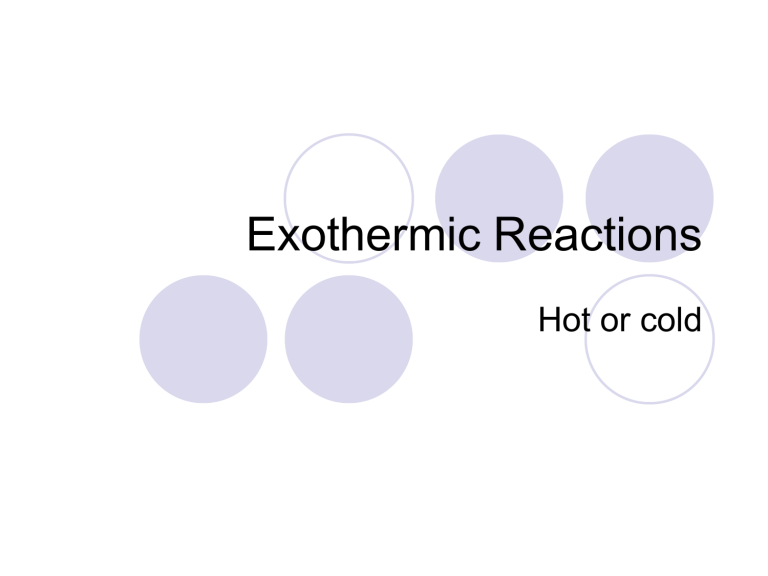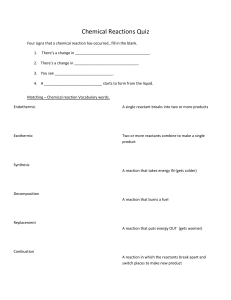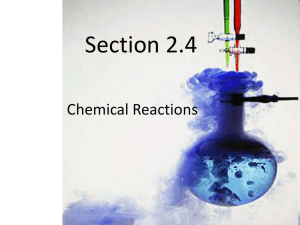Exothermic & Endothermic Reactions: Energy Diagrams & Calculations
advertisement

Exothermic Reactions Hot or cold From your syllabus… Lesson Objectives We are learning to:Identify exothermic and endothermic reactions What I’m Looking For:You must be able to be able to assign thermic reactions as +ΔH or –ΔH You should be able to construct a simple energy level diagram for endo- and exo- thermic reaction You could be able to calculate the energy change in a reaction using bond enthalpies Exothermic Reactions Magnesium + Hydrochloric acid 25o C 45o C magnesium Gets hot Hydrochloric acid Heat energy given out Exothermic Reactions If heat is given out this energy must have come from chemical energy in the starting materials (reactants). 45 25o C Reactants convert chemical energy to heat energy. The temperature rises. Exothermic Reactions Almost immediately the hot reaction products start to lose heat to the surroundings and eventually they return to room temperature. 25o C 45 Chemical energy becomes heat energy. The reaction mixture gets hotter. Eventually this heat is lost to the surroundings. It follows that reaction products have less chemical energy than the reactants had to start with. Energy Level Diagram for an Exothermic Reaction Energy / kJ) reactants Reactants have more chemical energy. Some of this is lost as heat which spreads out into the room. products Progress of reaction (time) Products now have less chemical energy than reactants. Energy Level Diagram for an Exothermic Exothermic Reaction Reaction 2. H is how much energy is given out Energy / kJ reactants H=negative products Progress of reaction H is negative because the products have less energy than the reactants. Exothermic Reaction - Definition Energy / kJ) Exothermic reactions give out energy. There is a temperature rise and H is negative. reactants H is negative products Progress of reaction Activity Endothermic Reactions Endothermic reactions cause a decrease in temperature. Endothermic chemical reactions are relatively rare. A few reactions that give off gases are highly endothermic - get very cold. Dissolving salts in water is another process that is often endothermic. Endothermic Reactions Endothermic reactions cause a decrease in temperature. Ammonium nitrate Cools Water Starts 25°C Cools to 5°C Heat energy taken in as the mixture returns back to room temp. Returns to 25°C Endothermic Reactions Extra energy is needed in order for endothermic reactions to occur. This comes from the thermal energy of the reaction mixture which consequently gets colder. Reactants convert heat energy into chemical energy as they change into products. The temperature drops. o oC 5 25 C Endothermic Reactions The cold reaction products start to gain heat from the surroundings and eventually return to room temperature. o oCC 25 5 The reactants gain energy. This comes from the substances used in the reaction and the reaction gets cold. Eventually heat is absorbed from the surroundings and the mixture returns to room temperature. Overall the chemicals have gained energy. Energy Level Diagram for an Endothermic Process Energy / kJ) products H=+ reactants Progress of reaction This is how much energy is taken in This is positive because the products have more energy than the reactants. Endothermic Reaction Definition Endothermic reactions take in energy. There is a temperature drop and H is positive. Energy / kJ products H=+ reactants Progress of reaction Exothermic Reaction - Definition Energy / kJ) Exothermic reactions give out energy. There is a temperature rise and H is negative. reactants H is negative products Progress of reaction Activity Endothermic Reactions Endothermic reactions cause a decrease in temperature. Endothermic chemical reactions are relatively rare. A few reactions that give off gases are highly endothermic - get very cold. Dissolving salts in water is another process that is often endothermic. Activity Are these endothermic or exothermic? 1. A red glow spread throughout the mixture exo and the temperature rose. 2. The mixture bubbled vigorously but the endo temperature dropped 150C. 3. Hydrazine and hydrogen peroxide react so explosively and powerfully that they exo are used to power rockets into space. 4. The decaying grass in the compost maker was considerably above the outside temperature. exo Activity Sketch the two energy diagrams and label exothermic and endothermic as appropriate. H=products Progress of reaction products Energy / kJ Energy / kJ) reactants H=+ reactants Progress of reaction Breaking chemical bonds Most chemicals will decompose (break up) if we heat them strongly enough. This indicates that breaking chemical bonds requires energy – is an endothermic process. Energy needed to overcome the bonding between the atoms Energy in chemicals Heat taken in Energy needed Making chemical bonds It is reasonable to assume that bond making will be the opposite of bond breaking Energy will be given out in an exothermic process when bonds are formed. Energy given out as bonds form between atoms Energy in chemicals Heat given out Energy given out Changes to chemical bonds Endothermic Reactions In most chemical reactions some existing bonds are broken (endothermic) Energy taken in as old bonds break Energy given out as new bonds form Overall endothermic in this case H Energy in chemicals • But new bonds are made (exothermic) reactants products Changes to chemical bonds Exothermic Reactions Again some existing bonds are broken (endothermic) Energy taken in as old bonds break reactants Overall exothermic – in this case Energy given out as new bonds form H Energy in chemicals • And new bonds are formed (exothermic) products Summary – Bond Changes reactants products H Bonds form Endo Bonds break Bond forming products Energy in chemicals reactants Exo H Bonds break Energy in chemicals Where the energy from bond forming exceeds that needed for bond breaking the reaction is exothermic. Where the energy for bond breaking exceeds that from bond forming the reaction is endothermic. Calculating bond energy changes Bond energies are measured in kJ/mole. For example, the bond energy of the O=O bond is 498 kJ/mole. This means that 498 kJ is needed to break a mole of these bonds, but 498 kJ is given out when a mole of these bonds is made. There are three steps involved in calculating a bond energy change: 1. Add up the bond energies for all the bonds in the reactants. This is the energy in. 2. Add up the bond energies for all the bonds in the products. This is the energy out. 3. The energy change = energy in energy out If the answer is negative, it is an exothermic reaction. If the answer is positive, it is an endothermic reaction. Bond Bond energy in kJ/mole H-H I-I H-I 436 151 298 Another example Word eq: Methane + oxygen carbon dioxide + water vapour Symbol eq: Bond energy Bond Draw the bonds in kJ/mole Now draw a pathway diagram C-H 435 O=O 498 C=O 803 O-H 464 The answer… Symbol eq: CH4 + 2O2 CO2 + 2H2O (4 x 435) + (2 x 498) (2 x 803) + (4 x 464) 1740 + 996 1606 + 1856 2736 3462 Bond = -726 kJ/mol Bond energy in kJ/mole So it is exothermic C-H 435 (as it is negative) O=O 498 C=O O-H 803 464 The Pathway diagram /kJ -726 kJ/mol Progress of reaction One more example, work out the the overall energy change and draw a pathway diagram Word eq: nitrogen + hydrogen ammonia Symbol eq: Bond Draw Bond Now draw a pathway diagram N=N H-H N-H energy in kJ/mole 944 436 388 The answer Symbol eq: N2 + 3H2 2NH3 944 + (3 x 436) (6 x 388) 2252 2328 = -76 kJ/mol Bond N=N H-H N-H Bond energy in kJ/mole 944 436 388





